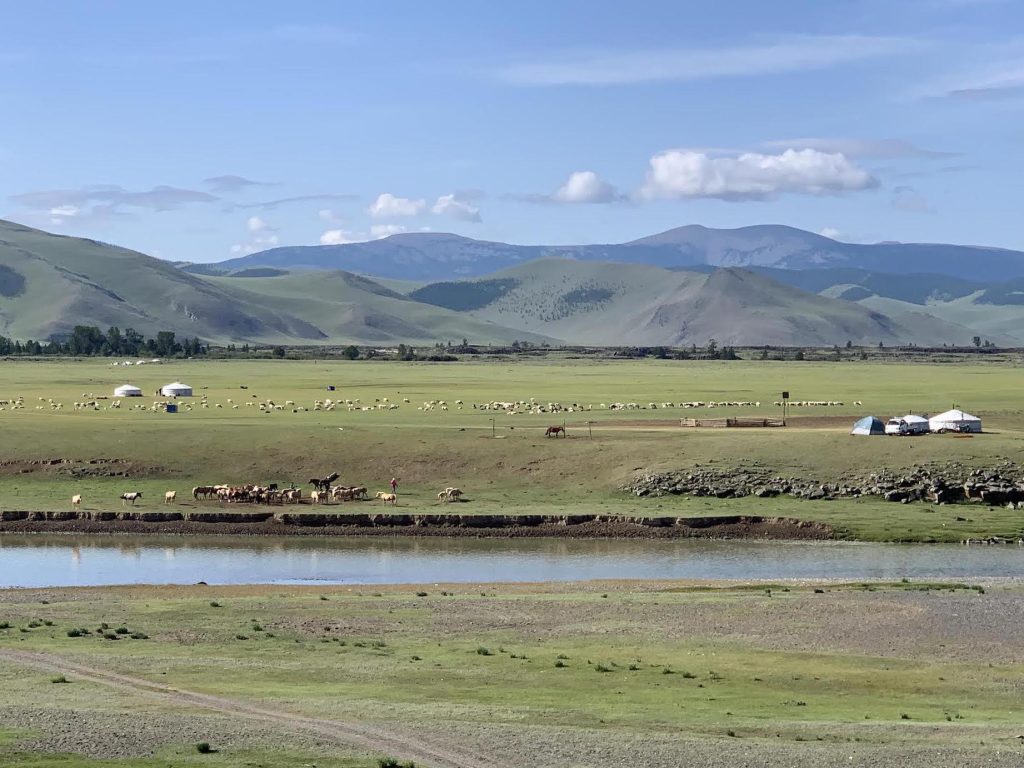At Home in Mongolian

This article was first published in The Linguist 62/3 in September 2023.https://www.ciol.org.uk/sites/default/files/TheLinguist-Autumn23.pdf
Over thirty years have passed since Mongolia opened up to the free world, but its national culture and language remain comparatively unknown. Many people still picture Mongolia as a vast expanse of grassy steppe across which nomadic herders wander at will in search of better grazing. This romantic notion poses challenges to linguists and others keen to correct embedded cultural misconceptions.
Mongolia is in fact the 19th largest country by area in the world. About 40% of its 3.4 million total population are herders. Many of the remainder live in the capital. To provide insights to the culture, I would like to take you on a journey through the key cultural concepts ‘dwelling place’ and ‘home’ starting with my favourite poem, ‘Bi Mongol Hun’ (‘I am a Mongol’) by Ch. Chimed. The first verse, in my translation reads:
“I, born in a herdsman’s ger (yurt)
From which dried-dung smoke ascends-
My nutag (dwelling-place) in the wilds-
I think of it as my cradle.”
Here the poet’s home is the family ‘ger’ (a wood-lattice, felt and canvas yurt) )where he was born. His nutag rendered as ‘dwelling place’, is the area where that ‘ger’ has been pitched. Mongolian herders move their homes with the seasons, four or five times a year, usually returning to the same places each season. In this way, winter and spring are passed in sheltered places, ideally with good access to fuel and water; summer grazing is not over-used; and the autumn wild hay harvest is scythed in good time ahead of ice and snow.
Thus there is no random ‘nomadic’ drifting at all, but a stable and sustainable pastoral cycle (barring natural disasters). If conditions allow, the distance from place to place may be only a few kilometres. The area containing all of a family’s annual ger sites effectively comprises their nutag. Where one was born is also one’s nutag, as in the poem above.
As a member of the Altaic language group, Mongolian is a classic example of an agglutinative language. Illustrating this using the word-stems of ger and nutag gives a good sense of how fundamental these concepts are. The agglutinations of nutag are particularly revealing.
nutaglah (to pitch one’s ger, to settle, make a habitation)
nutagshih (to get used to a new dwelling place)
nutgiinhan (those from a particular nutag)
nutgarhag (favouring people from one’s own nutag)
And -perhaps most meaningful of all-
nutagluulah (to lay a deceased person to rest).
In this way, nutag embodies the journey of life, starting from one’s birthplace, ‘one’s ‘cradle’, to returning to one’s final resting place. Thus the nutag where the ger is pitched creates the locus for human existence in harmony with nature, especially with the livestock on which herders’ lives depend.
The Mongol ger is largely unaltered in its design for centuries. Its furnishings are arranged identically according to ancient custom. It can be packed up or erected in a couple of hours, and can be simply adapted for perfect comfort in torrid heat or the bitterest cold. The door always faces into the morning sun. A source of water should be nearby, and will be kept rigorously pure. Firewood may be brought from a nearby forest, but dried cow dung, as in the poem, also makes an excellent peat-like fuel, whose smoke is scented with wild herbs. Here are some examples of agglutinations of ger.
ger bul (family)
gerleh (to get married)
gergii (a wife)
geriinhenteigee (with one’s own family)
gergiitei (a married man)
As these words show, the physical and conceptual ger constitutes the shared core of Mongol social experience; it is literally a ‘circle of life’, where young and old each have their accustomed place. Etymology and tradition ensure Mongol speakers absorb a particular sense of ‘home’ and ‘dwelling-place’ even if they were not themselves born in a ger scented with dried-dung smoke, pitched in the wilderness.
Today many Mongols are urbanised and live in blocks of flats or wooden houses, but they still use the word ger to mean home. For townsfolk nutag comes to mean their own rural birthplace, or for later generations, refers to where the family originally came from.
Thus, they are not foot-loose nomads. A sense of belonging to a particular place is still hard-wired into the personal identity of most Mongols even in this rapidly evolving culture.
Enkhee Namsrai MCIL CL is a Mongolian language and culture consultant providing training to clients including the UK Foreign, Commonwealth and Development Office.
